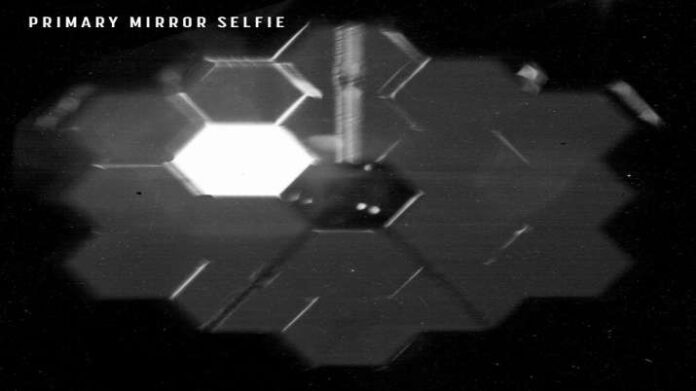| Translate This News In |
|---|
The first starlight has been captured by NASA’s new space telescope, which has also taken a selfie of its massive gold mirror.
Officials reported on Friday that 1 1/2 months into the mission, all 18 parts of the James Webb Space Telescope’s primary mirror appear to be operational.
A brilliant star 258 light-years away in the constellation Ursa Major was the telescope’s first target.
“That was just a great wow moment,” said Marshall Perrin of the Baltimore-based Space Telescope Science Institute.
The hexagonal mirror pieces will be aligned and focussed as one during the next two months, allowing science observations to begin by the end of June.
The $10 billion infrared observatory, which is expected to succeed the Hubble Space Telescope, will look for light from the universe’s initial stars and galaxies almost 14 billion years ago. It’ll also look for signs of life in the atmospheres of other worlds.
Focus!
@NASAWebb’s Near Infrared Camera, or NIRCam, recently became operational and captured this “selfie” of the telescope’s primary mirror. Webb will continue aligning its 18 mirrors over the next three months before it can #UnfoldtheUniverse: https://t.co/ppajknCrBm pic.twitter.com/ogx5OVe1Ue— NASA (@NASA) February 11, 2022
Hubble’s mirror problem was not discovered until after the telescope’s debut in 1990, and it took more than three years for spacewalking astronauts to rectify the telescope’s fuzzy vision.
While Webb appears to be in fine shape thus far, Feinberg believes engineers will be able to rule out any serious mirror issues by the end of next month.
Webb’s gold-plated mirror is the largest ever sent into space, measuring 21 feet (6.5 metres). As one portion of the mirror peered towards the target star, an infrared camera on the telescope took an image of it.
“It was very much ‘Holy Cow!'” remarked Feinberg.
The selfie, as well as a mosaic of starlight from each of the mirror pieces, were provided by NASA. The 18 starlight spots like dazzling fireflies flying over a dark night sky.
Focus!
@NASAWebb’s Near Infrared Camera, or NIRCam, recently became operational and captured this “selfie” of the telescope’s primary mirror. Webb will continue aligning its 18 mirrors over the next three months before it can #UnfoldtheUniverse: https://t.co/ppajknCrBm pic.twitter.com/ogx5OVe1Ue— NASA (@NASA) February 11, 2022
Marcia Rieke, chief scientist for the infrared camera at the University of Arizona, stated that after 20 years on the project, “it is simply wonderfully satisfying” to see everything operating so well so far.
Webb took out from South America in December and arrived at its final destination last month, 1 million miles (1.6 million kilometres) distant.


















